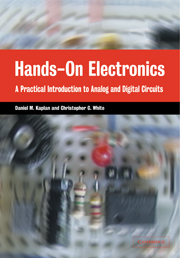Book contents
- Frontmatter
- Contents
- List of figures
- List of tables
- About the authors
- To the Reader
- Acknowledgments
- Introduction
- 1 Equipment familiarization: multimeter, breadboard, and oscilloscope
- 2 RC circuits
- 3 Diodes
- 4 Bipolar transistors
- 5 Transistors II: FETs
- 6 Transistors III: differential amplifier
- 7 Introduction to operational amplifiers
- 8 More op amp applications
- 9 Comparators and oscillators
- 10 Combinational logic
- 11 Flip-flops: saving a logic state
- 12 Monostables, counters, multiplexers, and RAM
- 13 Digital↔analog conversion
- Further reading
- Appendix A Equipment and supplies
- Appendix B Common abbreviations and circuit symbols
- Appendix C RC circuits: frequency-domain analysis
- Appendix D Pinouts
- Glossary of basic electrical and electronic terms
- Index
7 - Introduction to operational amplifiers
Published online by Cambridge University Press: 06 July 2010
- Frontmatter
- Contents
- List of figures
- List of tables
- About the authors
- To the Reader
- Acknowledgments
- Introduction
- 1 Equipment familiarization: multimeter, breadboard, and oscilloscope
- 2 RC circuits
- 3 Diodes
- 4 Bipolar transistors
- 5 Transistors II: FETs
- 6 Transistors III: differential amplifier
- 7 Introduction to operational amplifiers
- 8 More op amp applications
- 9 Comparators and oscillators
- 10 Combinational logic
- 11 Flip-flops: saving a logic state
- 12 Monostables, counters, multiplexers, and RAM
- 13 Digital↔analog conversion
- Further reading
- Appendix A Equipment and supplies
- Appendix B Common abbreviations and circuit symbols
- Appendix C RC circuits: frequency-domain analysis
- Appendix D Pinouts
- Glossary of basic electrical and electronic terms
- Index
Summary
An operational amplifier is a high-gain DC-coupled amplifier with differential inputs and single-ended output. Op amps were originally developed as vacuum-tube circuits to be used for analog computation. Nowadays they are packaged as integrated circuits (ICs). Such devices can closely approximate the behavior of an ideal amplifier, and their use avoids the necessity of coping with the messy internal details of amplifier circuitry. Thus, an IC op amp is often the device of choice in scientific instrumentation. In this chapter we will introduce the op amp and its most common applications.
Apparatus required
Breadboard, oscilloscope, multimeter, two 741 op amps, one further 741 (optional), one 100 Ω, three 10 k, two 100 k, one 1 M 14 W resistors, and four more 10 k resistors (optional).
The 741 operational amplifier
The IC we shall be using is a general purpose op amp designated by the number 741. The 741 is a very popular and successful design, useful for signals from DC to beyond audio frequency (though in recent years FET-input op amps such as the LF411 have been gaining on the 741 in popularity). It is available from most manufacturers of linear integrated circuits (chips that produce an output proportional to their inputs, as opposed to digital ICs, whose outputs have typically only two states).
Each manufacturer has a different system of nomenclature for ICs, e.g. National Semiconductor calls the 741 an LM741, Fairchild a μA741, etc., but the 741s made by different manufacturers are all electrically compatible.
Information
- Type
- Chapter
- Information
- Hands-On ElectronicsA Practical Introduction to Analog and Digital Circuits, pp. 85 - 100Publisher: Cambridge University PressPrint publication year: 2003
